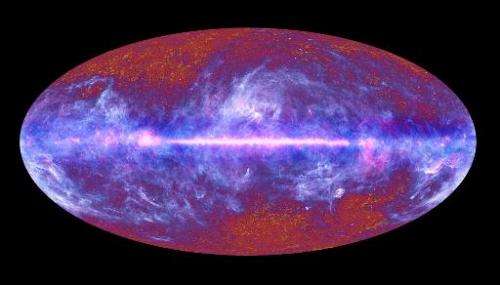Europe's Planck telescope set for retirement

The deep-space Planck telescope will retire this week after a successful four-year mission that revealed our Universe to be 80 million years older than previously thought, the European Space Agency said as it prepared Monday for switch-off.
Mission controllers fired Planck's thrusters to empty its fuel tanks—one of the final steps before the spent satellite can be "parked" in a safe orbit around the Sun, far away from the Earth and Moon, where it will stay for hundreds of years after it goes out of action Wednesday.
"The final step will be the simple act of switching off the transmitters: we will witness the silencing of Planck and we will never receive a signal from her again," ESA spacecraft operations manager Steve Foley said in a statement.
"This is important because we cannot cause radio interference for any future mission."
The procedure to put Planck in a "permanently safe configuration" is similar to that employed for its sister satellite Herschel earlier this year.
Launched together in May 2009, Herschel was tasked with studying the origin of stars and galaxies while Planck was to look at radiation remnants from the "Big Bang" that created the Universe some 14 billion years ago.
Named after the 20th-century German physicist Max Planck, founder of quantum theory, the satellite was equipped with a massive telescope to measure the temperature of Cosmic Microwave Background (CMB) emissions.
In March, ESA unveiled a 50-million pixel, all-sky snapshot of radiation left over from the Big Bang, compiled from data gathered by the orbiter.
"This is a giant leap in our understanding of the origins of the Universe," ESA director-general Jean-Jacques Dordain said as the map of the most ancient light in the cosmos was made public.
The data showed the Universe to be expanding at a slower rate than previously thought, which required adjusting its age to 13.82 billion years.
To take its measurements, the 4.2-metre (13.7-foot) by 4.2-metre Planck satellite's detectors had to be cooled to near absolute zero (minus 273.15 degrees Celsius/minus 459.67 degrees Fahrenheit).
It was capable of measuring temperature variations of a few millionths of a degree.
Planck was designed to carry out two full sky surveys over a period of 15 months, but instead observed the sky for more than 30 months and completed five surveys.
All science operations came to an end on October 3.
Switch-off will be marked by a small ceremony on Wednesday, with project scientist Jan Tauber sending the final command, ESA said.
"Our business is keeping missions alive and productive, so sending a shut-down command is very difficult," added Paolo Ferri, head of mission operations at ESA's space operations centre.
© 2013 AFP





















